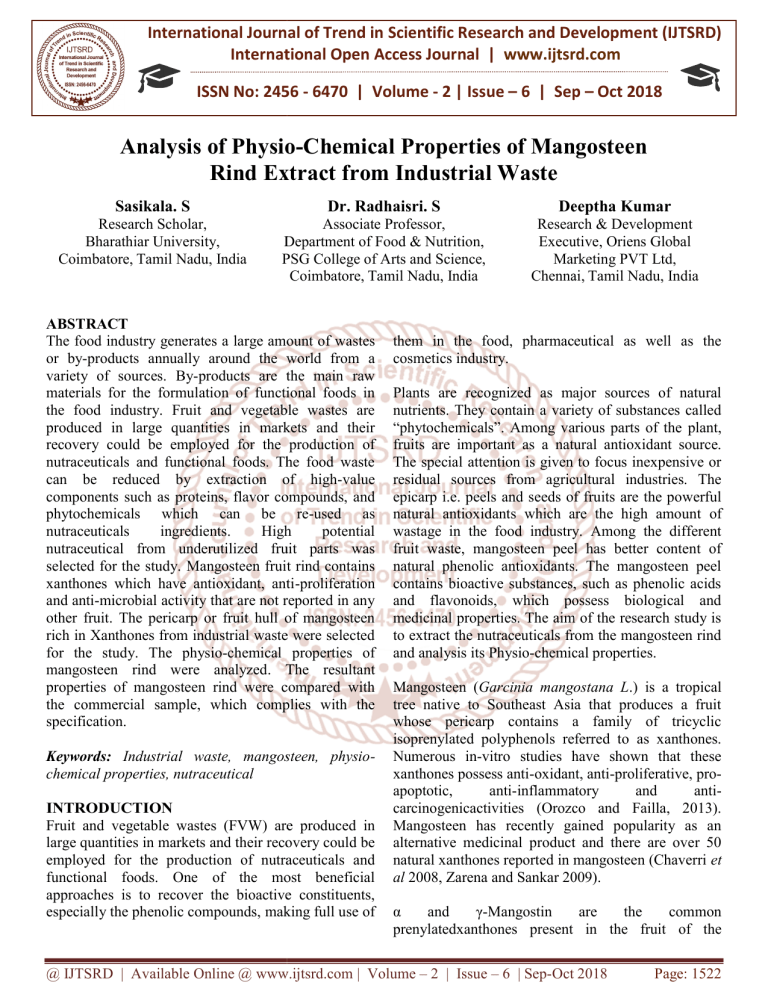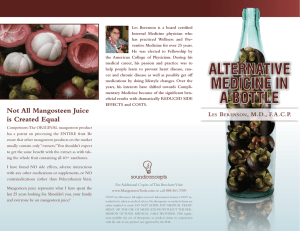
International Journal of Trend in Scientific Research and Development (IJTSRD)
International Open Access Journal | www.ijtsrd.com
ISSN No: 2456 - 6470 | Volume - 2 | Issue – 6 | Sep – Oct 2018
Analysis of Physio
Physio-Chemical
Chemical Properties of Mangosteen
Rind Extract ffrom Industrial Waste
Sasikala. S
Dr. Radhaisri. S
Deeptha Kumar
Research Scholar,
Bharathiar University,
Coimbatore, Tamil Nadu, India
Associate Professor,
Department of Food & Nutrition,
PSG College of Arts and Science,
Coimbatore, Tamil Nadu, India
Research
esearch & Development
Executive, Oriens Global
Marketing PVT Ltd,
Chennai,
Chennai Tamil Nadu, India
ABSTRACT
The food industry generates a large amount of wastes
or by-products
products annually around the world from a
variety of sources. By-products
products are the main raw
materials for the formulation of functional foods in
the food industry. Fruit and vegetable wastes are
produced in large quantities in markets and their
recovery could be employed for the production of
nutraceuticals and functional foods. The food waste
can be reduced by extraction of high
high-value
components such as proteins,
oteins, flavor compounds, and
phytochemicals which can be re
re-used as
nutraceuticals
ingredients.
High
potential
nutraceutical from underutilized fruit parts was
selected for the study. Mangosteen fruit rind contains
xanthones which have antioxidant, anti
anti-proliferation
and anti-microbial
microbial activity that are not reported in any
other fruit. The pericarp or fruit hull of mangosteen
rich in Xanthones from industrial waste were selected
for the study. The physio-chemical
chemical properties of
mangosteen rind were analyzed.. The resultant
properties of mangosteen rind were compared with
the commercial sample, which complies with the
specification.
Keywords: Industrial waste, mangosteen, physio
physiochemical properties, nutraceutical
INTRODUCTION
Fruit and vegetable wastes (FVW)) are produced in
large quantities in markets and their recovery could be
employed for the production of nutraceuticals and
functional foods. One of the most beneficial
approaches is to recover the bioactive constituents,
especially the phenolic compounds, making full use of
them in the food, pharmaceutical as well as the
cosmetics industry.
Plants are recognized as major sources of natural
nutrients. They contain a variety of substances called
“phytochemicals”. Among various parts of the plant,
fruits are important as a natural antioxidant source.
The special attention is given to focus inexpensive or
residual sources from agricultural industries. The
epicarp i.e. peels and seeds of fruits are the powerful
natural antioxidants which are the high amount of
wastage in the food industry. Among the different
fruit waste, mangosteen peel has better content of
natural phenolic antioxidants. The mangosteen peel
contains bioactive substances, such as phenolic acids
and flavonoids, which possess biological and
medicinal
dicinal properties. The aim of the research study is
to extract the nutraceuticals from the mangosteen rind
and analysis its Physio-chemical
chemical properties.
Mangosteen (Garcinia mangostana L.)
L is a tropical
tree native to Southeast Asia that produces a fruit
whose pericarp contains a family of tricyclic
isoprenylated polyphenols referred to as xanthones.
Numerous in-vitro studies have shown that these
xanthones possess anti-oxidant,
oxidant, anti-proliferative,
anti
proapoptotic,
anti-inflammatory
inflammatory
and
antianti
carcinogenicactivities (Orozco and Failla, 2013).
Mangosteen has recently gained popularity as an
alternative medicinal product and there are over 50
natural xanthones reported in mangosteen (Chaverri et
al 2008, Zarena and Sankar 2009).
α
and
γ-Mangostin
Mangostin
are
the
common
prenylatedxanthones
renylatedxanthones present in the fruit of the
@ IJTSRD | Available Online @ www.ijtsrd.com | Volume – 2 | Issue – 6 | Sep-Oct
Oct 2018
Page: 1522
International Journal of Trend in Scientific Research and Development (IJTSRD) ISSN: 2456-6470
2456
mangosteen tree. They have been reported to possess
numerous bioactivities that have provided the impetus
for use of mangosteen products as nutraceuticals and
dietary supplements. The health-promoting
promoting benefits of
mangosteen are dependent on delivery of the
xanthones to target tissues (Obolskiy et al 2009).
Mangosteen peel contains a large number of
xanthones (especially -mangosteen).
). It has been
used as traditional medicine and is popularly applied
to constitute cosmetic and pharmaceutical products.
However, there is only a little information available
for quality and quantity determination of
mangosteen in mangosteen (Yodhnu et al 2009).
Because α-mangostin represents the majority of the
clinical benefits of this herbal medicine, it is
reasonable and logical to determine the concentration
of α-mangosteen as a chemical marker for the quality
control of G. mangostana and its products, which
usually is the only xanthone ingredient quantity
quantitymarked in the label (Zarena and Sankar, 2009).
METHODOLOGY
Selection of Sample
Mangosteen fruit was purchased from the local
market in Chennai.
Chemicals, Glassware, and Reagents
Test tube, Incubator Shaker, High-speed
speed blender,
Centrifuge, Conical Flask, Beaker, Ethanol, distilled
water
Mangosteen Extract
The edible part of the fruit, constituting the aril, which
is freshly eaten, dried, frozen or canned only amounts
to about 30 percent of its fresh weight, while the
pericarp and seed are considered as waste (Okonogi et
al 2007).The Fruit rind of Mangosteen has been used
as a traditional medicine for antidiarrhea,
antidysenteric and treatment of wounds(Gritsanapan
and Chulasiri, 1983). It is reported to contain several
groups of phenolic compounds such as tannins,
flavonoids, and xanthones supporting its traditional
use (Fransworth and Bunyapraphatsara, 1992 and Yu
et al 2007). A major
ajor xanthone in the fruit rind is α
α-
mangosteen (Walker, 2007 and Chen et al 2008). Due
to the hydroxyl groups, attached to the unsaturated
heterocyclic xanthone core, xanthones exert high
antioxidant activity (Martinez et al 2011).
Mangosteens are free-radical
adical scavengers and inhibit
the oxidation of Low-Density
Density Lipoproteins (LDL-C)
(LDL
cholesterol (Williams et al 1995 and Mahabusarakam
et al 2000). Mangosteen Fruit Extract is popularly
used as a food supplement due to antioxidant activity.
Recently Garciniamangostana
gostana Fruit rind extract has
become popular, used as a dietary supplement, herbal
medicine and cosmetic combination. The Biological
quality of mangosteenderived products is based on the
contents of α- mangosteen,, tannins and other phenolic
compounds (Pothitirat et al 2010).
Plate I –Mangosteen
Mangosteen fruit
The yield of α-mangostin from the dried pericarp was
approximately 0.4 percent (w/w) (Torrungruang and
Chutimaworapan, 2007). Low antioxidant activity in
hexane extract may be due to the polar nature of
compounds
mpounds which are not completely extracted in
hexane extract whereas acetone and ethyl acetate
extracts are able to percolate the matrix thus
enhancing the solubility (Zarena and Sankar, 2009).
Higher absorbance indicated higher activity; ethyl
acetate extract showed strongest antioxidant property,
ethyl acetate and acetone extract showed good
antioxidant activity except in the chelating assay the
extraction yield and antioxidant potential of the
compounds in the extract is strongly dependent on the
solvent polarity. Our results indicate the active
constituents in mangosteen have intermediate polarity
and hence can be easily extracted by ethyl acetate or
acetone as the extraction solvent. The extraction
extr
of
mangosteen pericarp in ethyl acetate extract showed
maximum antioxidant activity and free radical
scavenging activities in vitro conditions (Zarena and
Sankar, 2009).
The xanthones in the different solvents (ethyl acetate,
acetone, and hexane), was
as investigated by means of
high-performance
liquid
chromatographyelectrosprayionization/mass
/mass spectrometry (HPLC
ESI/MS) technique. The maximum yield was obtained
@ IJTSRD | Available Online @ www.ijtsrd.com | Volume – 2 | Issue – 6 | Sep-Oct
Oct 2018
Page: 1523
International Journal of Trend in Scientific Research and Development (IJTSRD) ISSN: 2456-6470
2456
from ethyl acetate when compared to minimum yields
of hexane extracts respectively (Zarena aand Sankar,
2009).
According to Nabandith et al 2004, ethyl acetate used
as a solvent to extract the mangosteen from the
Garciniamangostana reported the extract was
composed of 77.8 percent α- mangosteen and 15.9
percent γ- mangosteen
It has been reported that dichloromethane was the
most suitable solvent for extraction of α
α-mangostin
from Garcinia mangostana pericarps (Pothitirat,
Chomnawang, and Gritsanapan, 2010). However, the
use of dichloromethane, halogenated hydrocarbon as a
solvent for extraction is restricted due to its toxicities
(Calepa, 2000) and limitations on its use in the
development of herbal products. Nowadays
Nowadays, industrial
regulations require a diminished cons
consumption of
petrochemical solvents and volatile organic
compounds. Moreover, the absence of risk during
extraction and the safety of the ingredients used are a
major concern and have drawn attention towards the
need to use a greener solvent (Rombaut et al 2014).
Alternative green solvents, a renewable resource
produced from biomasses such as wood, starch,
vegetable oils or fruits are high power, biodegradable,
low toxicity, and low flammability. Extensive studies
have shown the importance and the reported pote
potential
of green solvents that could be alternatively used
instead of the petrochemical solvents, e.g. extraction
of fat and oils from the rape seed using MeTHF
instead of hexane (Sicaire et al 2015) and extraction
of oil from microalgae using D-limonene
limonene inst
instead of
hexane (Tanzi et al 2012). Ethyl acetate will be
promising alternative solvents for the extraction of α
αmangosteen (Bundeesomchok, 2016). Considering
this ethyl acetate was used to extract mangosteen rind.
Mangosteen rind
Method of Extraction – Mangosteen Rind
Mangosteen
osteen fruit was purchased from the local
market in Chennai. The fruits were cleaned and the
edible part was removed. The fruit rinds were cut into
small pieces and dried in a hot oven at 50 °C for 72h.
The dried samples were ground into powder, passed
through
ough a sieve (20 meshes). The samples were
separately kept in airtight container and protected
from light until used.
The mangosteen rind was extracted by ethyl acetate
and xanthone-rich extract was obtained. Extractions
were carried out for 2 h that include initial boiling for
30 min. After filtering the extract through Whatman
No. 1 paper, each of the filtrates was concentrated
using rota evaporator at 40 °C, the weight of the
extract was noted and the final volume was
made up to 25 ml in a volumetric flask. The extract
was kept in airtight bottles and stored in a freezer at 20 °C. The extract was filtered with a muslin cloth.
The Bio-based
based solvent “Green Solvent” is used for the
extraction (Rojo et al 2012).
RESULTS AND DISCUSSION
The moisture content of mangosteen rind extract was
7.91 percent and the ash content was 2.49 percent.
The Xanthones percentage in the extract powder was
detected by HPLC method (Zarena and Sankar, 2009).
Table I: Physical and Chemical Characteristics of
Mangosteen Rind Extract
Tests
Results
Description Brown Colour Powder
Odor
Characteristic
Taste
Astringent
Ash (%)
2.49
Moisture (%)
7.91
Liquid solvent extract
Solid extract (powder)
Plate II: Extraction Picture – b) Mangosteen Rind
@ IJTSRD | Available Online @ www.ijtsrd.com | Volume – 2 | Issue – 6 | Sep-Oct
Oct 2018
Page: 1524
International Journal of Trend in Scientific Research and Development (IJTSRD) ISSN: 2456-6470
2456
The extraction of Mangosteen rind was spray dried
and it is brown in color,, astringent in taste. The
Mangosteen rind extract is soluble in water. The
Mangosteen rind extracted was compared with some
commercial sample and it’s similar in nature.
CONCLUSION
Food wastes or by-products
products convert to the functional
food ingredients it is the healthy trends in the food
industry. Waste management is one of the major parts
of food industries. The large volume of the low-cost
by-product gives the economical advantage of its
potentially valuable components and environmental
benefits. Mangosteen rinds were selected as an
industrial waste for assessing the physio
physio-chemical
properties. The selected mangosteen rind was similar
to the reviewed commercial
mercial sample. This mangosteen
rind can be utilized for the usage in the nutraceutical
products.
5. Fransworth, N.R and Bunyapraphatsara (1992),
Thai Medicinal plants, Recommended for primary
Health Care System, Bangkok, Prachachon
Company, 160-162.
Acknowledgment
The authors would like to express their deepest
gratitude to P. Karthikeyan, CEO, S. Moulishankar,
COO, S. Suman, CFO Oriens Global Marketing (P)
Ltd, India for financial support for this study and
permitting us to conduct this study. Our heartfelt
thanks go to the Parthiban Subramanian for his
guidance and support.
9. Nabandith, V., Suzui,, M., Morioka, T., Kaneshiro,
T., Kinjo, T., Matsumoto,
moto, K., Akao, Y., Iinuma,
M., Yoshimi, N (20014), Inhibitory effects of
crude alpha-mangostin,, a xanthone derivative, on
two different categories of colon preneoplastic
lesions induced by 1, 2-dimethylhydrazine
dimethylhydrazine in the
rat. Asian Pacific Journal of Cancer Prevention, 5,
433–438.
REFERENCE
1. Bundeesomchok, K., Filly, A., Rakotomanomana,
N., Panichayupakaranant,, P., Chemat, F (2016),
Extraction
of
a-mangosteen
mangosteen
from
Garciniamangostana L. using alternative solvents:
Computational predictive and experimental
studies, LWT – Food Science and Technology, 65,
297-303.
2. Calepa (California environmental protection
agency),, (2000), Public health goals for chemicals
in drinking water: Dichloromethane (methylene
chloride,
DCM),
Available
http://oehha.ca.gov/water/phg/pdf/dcm.pdf
(accessed 09.04.15).
3. Chaverri, J., Rodriguez, N., Ibarra, M., Rojas, J,
M (2008), Medicinal properties
ties of mangosteen
(Garciniamangostana), Food and Chemical
Toxicology, 46, 3227-3239.
4. Chen, L.G., Yang, L. L., Wang, C.C (2008), Anti
Antiinflammatory activity of mangostins from
Garciniamangostana,
Food
and
Chemical
Toxicology, 46, 688-693.
6. Gritsanapan, W and Chulasiri, M (1983), A
preliminary study of anti diarrheal plants: I.
Antibacterial activity, Mahidol university
u
journal
of pharmacology science, 10, 119-112.
119
7. Mahabusarakam, W., Proudfoot, J., Taylor, W.,
Croft, K (2000), Inhibition of lipoprotein
oxidation by prenylatedxanthones derived from
mangostin,, Free Radical Research, 33, 643–659.
643
8. Martinez, A., Galano,
no, A., Vargas, R (2011), Free
radical scavenger properties of alpha-mangostin:
alpha
Thermodynamics and kinetics of hat and raf
mechanisms, Journal of Physical Chemistry A,
115, 12591-12598.
10. Obolskiy, D., Pischel, I., Siriwatanametanon, N.,
Heinrich, M (2009), Garciniamangostana L A
phytochemical and pharmacological review,
Phytotherapy Research, 23, 1047–1065.
1047
11. Okonogi, S., Duangrat, C., Anuchpreeda, S.,
Tachakittirungrod,
rod, S., Chowwanapoonpohn, S
(2007), Comparison of antioxidant capacities and
cytotoxicities of certain fruit peels, Food
Chemistry, 103, 839-846.
12. Orozco, F.G and Failla, M.L (2013), Biological
Activities
and
Bioavailability
of
MangosteenXanthones A Critical Review of the
current evidence, 5(8), 3163-3183.
3163
13. Pothitirat, W., Chomnawang, T.M., Supabphol,
R., Gritsanapan, W ( 2010), Free Radical
Scavenging and anti-acne
acne activities of mangosteen
fruit rind extracts prepared by different extraction
methods, Journal
al of Pharmaceutical Biology,
48(2), 182-186.
14. Pothitirat, W., Chomnawang, T.M., Supabphol,
R., Gritsanapan, W ( 2010), Free Radical
Scavenging and anti-acne
acne activities of mangosteen
fruit rind extracts prepared by different extraction
@ IJTSRD | Available Online @ www.ijtsrd.com | Volume – 2 | Issue – 6 | Sep-Oct
Oct 2018
Page: 1522
International Journal of Trend in Scientific Research and Development (IJTSRD) ISSN: 2456-6470
2456
methods, Journal of Pharmaceutical
harmaceutical Biology,
48(2), 182-186.
15. Rombaut, N., Fabiano-Tixier,
Tixier, A, S., Bily, A.,
Chemat, F (2014), Green extraction processes of
natural products as tools for the biorefinery.
Biofuels, Bioproducts and Biorefining, 8, 530
530544.
16. Sicaire, A.G., Vian, M., Fine, F., Joffre, F., Carre,
P., Tostain, S (2015), Alternative bio
bio-based
solvents for extraction of fat and oils: solubility
prediction, global yield, extraction kinetics,
chemical composition and cost of manufacturing,
International Journal of Molecular Sciences, 16,
8430-8453.
17. Tanzi, C.D., Vian, M., Ginies, C., Chemat, F
(2012), Terpenes as Green Solvents for Extraction
of Oil from Microalgae, Molecules, 17, 8196
81968205.
18. Torrungruang, K., Chutimaworapan S (2007),
Effect of mangosteen pericarp extract on ce
cell
viability in human gingival fibroblasts,
Chulalongkorn University Dental Journal, 29, 75
7582.
19. Walker, E, B (2007), HPLC analysis of selected
xanthones in mangosteen Fruit, Journal of
Separation Science, 30, 1229- 1234.
20. Williams, P., Ongaskul, M., Proudfoot,
Proudfo J., Croft,
K., Beilin, L (1995), Mangostin Inhibits the
Oxidative Modification of Human Low Density
Lipoprotein, Free radical research, 23(2), 175-84.
175
21. Yodhnu, S., Sirikatitham, A., Wattanapiromsakul,
C (2009), Validation of LC for the Determination
of α-Mangosteen
Mangosteen in Mangosteen Peel Extract: A
tool
for
Quality
Assessment
of
Garciniamangostana
L,
Journal
of
Chromatographic Science, 47, 185-189.
185
22. Yu, L., Zhao, M., Yang, B., Zhaq, Q., Jiang, Y
(2007),
Phenolics
from
Hull
Of
Garciniamangostana Fruit And Their
Th Antioxidant
Activities, Food Chemistry, 104, 176-181.
176
23. Zarena, A, S and Sankar, K.U (2009), Screening
of
xanthone
from
mangosteen
(GarciniamangostanaL.) peels and their effect on
cytochrome c reductase and phosphomolybdenum
activity, Journal of Natural Products, 2, 23-30.
24. Zarena, A.S and Sankar, K.U (2009), Study of
Antioxidant Properties From Garciniamangostana
L.
Pericarp
Extract,
Acta
ScientiarumPolonorumTechnologia Alimentaria,
8(1), 23-34.
@ IJTSRD | Available Online @ www.ijtsrd.com | Volume – 2 | Issue – 6 | Sep-Oct
Oct 2018
Page: 1523




